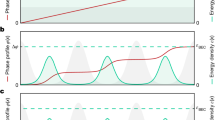Abstract
THEORIES of superfluidity usually assume the possibility of pure potential flow, provided that the flow velocity is less than some critical value (at which the creation of excitations first becomes possible)1,2. If we consider the flow of helium (at T = 0° K.), for example through a tube or along a Rollin film, it is implied that the boundary layer is slipping over the solid wall. However, the first few layers of helium atoms would not be expected to take part in this motion, as they are firmly bound by the van der Waals' attractions of the wall. The picture therefore has to be revised slightly to one in which there is a velocity discontinuity (that is, a vortex sheet) close to, but not coincident with, the solid wall. But a continuous vortex sheet implies a rather drastic change in the character of the wave function, over a distance of the order of one interatomic distance a, and hence implies a large energy per unit area, of the order of h̄ 2/ma4 (where m is the mass of an atom).
This is a preview of subscription content, access via your institution
Access options
Subscribe to this journal
Receive 51 print issues and online access
$199.00 per year
only $3.90 per issue
Buy this article
- Purchase on Springer Link
- Instant access to full article PDF
Prices may be subject to local taxes which are calculated during checkout
Similar content being viewed by others
References
Landau, L. D., J. Phys. (U.S.S.R.), 5, 71 (1941); 11, 91 (1947). Feynman, R. P., Phys. Rev., 94, 262 (1954).
Feynman, R. P., “Low Temperature Physics”, 1, 17 (North Holland Pub. Co., Amsterdam, 1955). Onsager, L., Nuovo cim. (ix), 6, Supp., 249 (1949).
See, for example, Milne-Thomson, L. M., “Theoretical Hydrodynamics”, 340 (Macmillan, London, 1948).
Contrast with the conventional interpretations; see, for example, Atkins, K.R., “Liquid Helium”, 90 (Cambridge University Press, 1959).
Author information
Authors and Affiliations
Rights and permissions
About this article
Cite this article
KUPER, C. Mechanism of Superfluid Flow. Nature 185, 832–833 (1960). https://doi.org/10.1038/185832a0
Issue Date:
DOI: https://doi.org/10.1038/185832a0
This article is cited by
-
Moving Helium Film Measurements
Nature (1964)
Comments
By submitting a comment you agree to abide by our Terms and Community Guidelines. If you find something abusive or that does not comply with our terms or guidelines please flag it as inappropriate.



